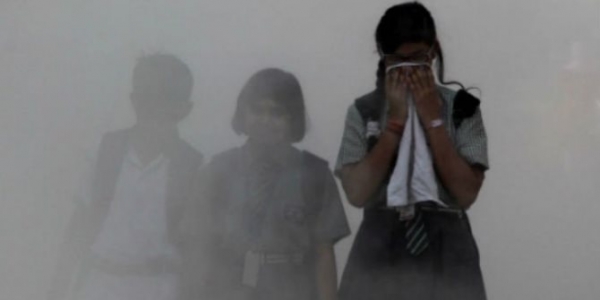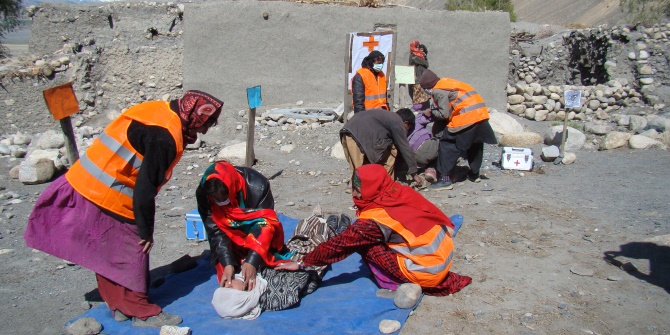Delhi has now overtaken Beijing as the most polluted city in the world and over Diwali the air quality deteriorated to new lows. In this article, Payal Dey discusses how serious the problem has become, highlights the Delhi government’s lethargic response to the current crisis and outlines policy suggestions for controlling smog in the Indian capital.
The World Health Organisation in 2014 rated Delhi as the most polluted of 1600 cities in the world. On Diwali – the festival of lights celebrated by close to 82 percent of the population of Delhi – the air quality deteriorated to its worst. It is of concern that despite warning of unfavourable weather conditions leading to smog by the government’s forecasting body (SAFAR), fireworks and firecrackers were used without restraint on the festive night of October 30. The blanket of smog over Delhi continues to put health of nearly 19 million people at risk, resulting in road accidents due to poor visibility and unaccounted damage to flora and fauna. This article captures the need for paying immediate attention for curbing air pollution, builds a case for a complete ban on firecrackers, fireworks and open fires, and recommends policy suggestions for controlling smog in the Indian capital.
Severity of air pollution
Air pollution is the fourth largest health risk globally responsible for close to 6.5 million premature deaths per year; of this 25 percent are in India. Since Diwali evening, air quality measured by Air Quality Index (AQI) has plunged to “severe” category, which is 40 times more toxic than the permissible limits. This level is considered hazardous and likely have serious health implications for all those exposed to it. The concentration of Particulate Matter – ultra fine particles which can reach lower regions of lungs and cause respiratory diseases on prolonged exposure – were found to be high by nearly five times the Indian safety standard and 10 times the WHO benchmark. Such level of pollution can effect breathing, damage lungs and may cause cancer and premature deaths. People with chronic diseases, elderly and children are especially sensitive to exposure to PM. According to UNICEF, 300 million children are breathing extremely toxic air in the world: which may cause irreversible damage to their brain and lungs, impair growth and overall health. Of this figure, an alarming 2.2 million or 50 percent of all school children are already affected in Delhi. With current state of affairs, the number of affected are expected to spiral.
Case of R.K. Puram
Dust, vehicular emission, construction activities and burning of crops from neighbouring states have been considered the common causes for smog in Delhi. If that were the case, AQI indices would not have skyrocketed during Diwali. The severity of the smog was due to mass burning of fireworks and firecrackers. Bans on selling and bursting of firecrackers till 10 pm on Diwali and followings days were neither implemented effectively nor complied by large chunk of population in R.K. Puram, a district in South Delhi. Even on a regular day, it is amongst the top three most polluted areas of the city. The district’s close proximity to the busiest ring road in the city adds to the pollution levels. But on Diwali the pollution peaked and it was the worst affected spot with AQI 42 times above safe limits.

R.K. Puram has close to 11,000 slum households, fifth largest slum in Delhi. As unorganised workforce, average tax free monthly income for a household in slum was INR 5,000-10,000 in 2013 and is estimated to rise to INR 15,000-20,000 at present. Utilities are either free or subsidised. With a culture of monetary bonuses during Diwali, slum dwellers, especially children and youth ceaselessly used fireworks and crackers without understanding the implications on health and environment. In Shanti Path for instance, which is the diplomatic area within R.K. Puram constituency and one of the least densely populated areas of the National Capital Region (NCR), the air quality is moderate even when it exceeds safety levels in R.K. Puram and other regions. Yet through the night of Diwali pollution entered homes on Shanti Path and air quality as recoded by the US Embassy exceeded 500, (where 400-500 is defined as ‘severe’). The PM 2.5 on the other hand reached 1218 ug/m3 exceeding 20 times the safe limit. The area consists of both large and small slums where there are usually a number of open fires, with wood and leaves burning regularly. Officers accommodation on Shanti Path in addition have servant quarters, which have as many as 6-7 family members staying in one room. It’s a challenge for local authorities to put a check on such a large population. Furthermore, since this population serves as a votebank for local politicians, the authorities are reluctant to impose stricter controls.
Specific long-term governance solutions
Despite New Delhi surpassing Beijing as the most polluted city in the world, there is no immediate, short or long term policy in place. In fact the issue requires consensus between the State and Central government as air pollution must be addressed as on priority. With pollution surging in Delhi during winters and smog continuing to envelop NCR, there is a need to objectively define ‘vague and general’ plans. If preventive measures are not implemented successfully, there is a need to resort to specific curative measures along with long-term solutions requiring political will.
- Bans: Evidence suggests that without effective enforcement bans lead to covert and unregulated sales. Both the central and Delhi government had banned sale of Chinese firecrackers during Diwali. The bans were however flouted by vendors to meet the demand of consumers since these were relatively cheaper than Indian brands. Awareness campaigns over past five years have reduced sales of Indian firecrackers by over 50 percent and shut down several firecracker manufacturers in Sivakasi. To promote this trend, increased taxes should be imposed on these products, along with making it mandatory to print warnings on labels of fireworks about their harmful impact on health and environment. Strongly enforcing bans on firecrackers – whether imported or Indian, is however the need of the hour, followed by similar action for open fires. The sale of fireworks and firecrackers is heavily regulated in many countries including Canada, Hong Kong, U.K., Singapore, Indonesia, and Malaysia for various reasons, including safety and environmental. While they are completely banned in select regions of cities, they can be used under controlled conditions during festivals in others. The onus of bans must lie equally on both sellers and users.
- Penalising bursting of crackers and open fires: Last year, the government of Delhi had started taking aggressive steps not just for curbing firecrackers but also open fires – it’s high time users of firecrackers and those lighting open fires are penalised. The Government of India issued directives in December, 2015 under Air Act, 1981 to take strict action against burning of leaves and other polluting items. These directives must be given teeth by the Government of Delhi. With the onset of winter people mostly in slums are seen gathering wood from trees/parks for open fires. The government needs to intervene and provide cleaner ways of heating and cooking to reduce the reliance on open fires.
- Planting trees: There was a campaign by the Delhi Government this year to plant one million trees and half a million medicinal saplings during monsoons. Trees in urban areas have been found to improve the overall air quality by removing air pollutants and vehicular emissions. Steps that ensure maintenance and survival of trees after the monsoon season must be undertaken by respective agencies along with public associations, and supervised by a third party.
- Awareness drives: It must be acknowledged that current awareness and education drives are making an impact only on select population, reaping slow results. Behavioural economics has the potential to transform consumer preferences by questioning non-rational decision making of people. Delhi citizens must be equipped to adopted better habits through heuristics: celebrating festivals in a clean and peaceful manner over the age-old norm of using firecrackers. To ensure this, experts must be engaged with awareness-building bodies and local MLAs.
- Issuing red alert: The present level of pollution in Beijing would have resulted in emergency provisions being deployed within 72 hours. This would include issuing health advisory for children, elderly and people with chronic diseases for staying indoors; and to all on avoiding physical exertion and exercising in the open to avoid prolonged exposure to polluted air. Further, schools would have been closed, vehicles restricted and polluting industries shut. Delhi on the other hand continued to function normally for the entire week! Many public schools had instructed children to wear anti-pollution masks, which was beyond their means. This government should have taken these steps urgently. They should distribute anti-pollution masks to the most vulnerable sections, if not to all, and medical facilities including oxygen cylinders, anti-allergens and emergency wards must also be made available in all NCR hospitals.
Governance measures
Air pollution is a pressing problem for the entire country today since half of the 20 most polluted cities of the world are in India. Although this is not the time for criticism but political action, it must be noted that right political intent can be measured by outcomes. For effective results, elected representatives must be seasoned, experienced and proactive, which is not the case many times. The current Minister for Environment of Delhi is in charge of multiple portfolios, including elections. The smog situation required concerted and timely steps but work done by Government of Delhi has been lukewarm. The previous Odd-Even formula of the Government of Delhi had also completely failed in addressing pollution woes, as the reduction in pollution levels during the scheme were found to be negligible.
The Government of Delhi takes pride in having the youngest cabinet in India; not just the cabinet members but also the advisors and consultants consist of youth, who believe in ‘risk taking or experimentation approach’ of business start-ups in policy making. Public resources are limited and demand accountability, hence sound and tested policies are need of the hour in the national capital. Demanding Delhi’s full statehood in order to solve every crisis is not an answer for solving any of the problems like pollution, floods, traffic, women’ safety, particularly in the short term. At a time when projects for 100 smart cities is being sanctioned in India, one of the oldest and most historic cities of the world is in shreds.
The recent spike in pollution demonstrates that current preventive and curative actions do not go far enough. With the Government of Delhi’s growing commitment towards elections in other Indian states, it is time for other stakeholders to step in. Policies on banning of direct pollutants would need to be backed by rule of law, followed by changing people’s perceptions and behaviour. Delhi must not be dealt like a city of ministers, expats and bureaucrats who can afford the luxury of air purifiers at their offices and residents, but as a city home to almost 19 million citizens who need to be able to move and breathe.
Note: This article gives the views of the author, and not the position of the South Asia @ LSE blog, nor of the London School of Economics. Please read our comments policy before posting.
About the Author
Payal Dey studied MSc in Public Policy and Administration at LSE in 2014. She can be contacted on payal.dey@gmail.com or @payal_2016






